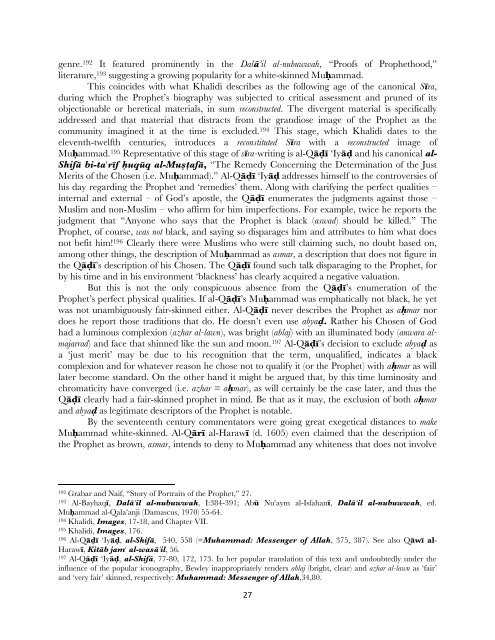Muhammad_Article.349.. - Dr. Wesley Muhammad
Muhammad_Article.349.. - Dr. Wesley Muhammad
Muhammad_Article.349.. - Dr. Wesley Muhammad
You also want an ePaper? Increase the reach of your titles
YUMPU automatically turns print PDFs into web optimized ePapers that Google loves.
genre. 192 It featured prominently in the Dal§"il al-nubuwwah, “Proofs of Prophethood,”<br />
literature, 193 suggesting a growing popularity for a white-skinned MuÈammad.<br />
This coincides with what Khalidi describes as the following age of the canonical SÊra,<br />
during which the Prophet’s biography was subjected to critical assessment and pruned of its<br />
objectionable or heretical materials, in sum reconstructed. The divergent material is specifically<br />
addressed and that material that distracts from the grandiose image of the Prophet as the<br />
community imagined it at the time is excluded. 194 This stage, which Khalidi dates to the<br />
eleventh-twelfth centuries, introduces a reconstituted SÊra with a reconstructed image of<br />
MuÈammad. 195 Representative of this stage of sÊra-writing is al-Q§∙Ê ‘Iy§∙ and his canonical al-<br />
Shif§ bi-ta#rÊf Èuqåq al-Mußãaf§, “The Remedy Concerning the Determination of the Just<br />
Merits of the Chosen (i.e. MuÈammad).” Al-Q§∙Ê ‘Iy§∙ addresses himself to the controversies of<br />
his day regarding the Prophet and ‘remedies’ them. Along with clarifying the perfect qualities –<br />
internal and external – of God’s apostle, the Q§∙Ê enumerates the judgments against those –<br />
Muslim and non-Muslim – who affirm for him imperfections. For example, twice he reports the<br />
judgment that “Anyone who says that the Prophet is black (aswad) should be killed.” The<br />
Prophet, of course, was not black, and saying so disparages him and attributes to him what does<br />
not befit him! 196 Clearly there were Muslims who were still claiming such, no doubt based on,<br />
among other things, the description of MuÈammad as asmar, a description that does not figure in<br />
the Q§∙Ê’s description of his Chosen. The Q§∙Ê found such talk disparaging to the Prophet, for<br />
by his time and in his environment ‘blackness’ has clearly acquired a negative valuation.<br />
But this is not the only conspicuous absence from the Q§∙Ê’s enumeration of the<br />
Prophet’s perfect physical qualities. If al-Q§∙Ê’s MuÈammad was emphatically not black, he yet<br />
was not unambiguously fair-skinned either. Al-Q§∙Ê never describes the Prophet as aÈmar nor<br />
does he report those traditions that do. He doesn’t even use abya∙. Rather his Chosen of God<br />
had a luminous complexion (azhar al-lawn), was bright (ablaj) with an illuminated body (anwara almajarrad)<br />
and face that shinned like the sun and moon. 197 Al-Q§∙Ê’s decision to exclude abya∙ as<br />
a ‘just merit’ may be due to his recognition that the term, unqualified, indicates a black<br />
complexion and for whatever reason he chose not to qualify it (or the Prophet) with aÈmar as will<br />
later become standard. On the other hand it might be argued that, by this time luminosity and<br />
chromaticity have converged (i.e. azhar = aÈmar), as will certainly be the case later, and thus the<br />
Q§∙Ê clearly had a fair-skinned prophet in mind. Be that as it may, the exclusion of both aÈmar<br />
and abya∙ as legitimate descriptors of the Prophet is notable.<br />
By the seventeenth century commentators were going great exegetical distances to make<br />
MuÈammad white-skinned. Al-Q§rÊ al-HarawÊ (d. 1605) even claimed that the description of<br />
the Prophet as brown, asmar, intends to deny to MuÈammad any whiteness that does not involve<br />
192 Grabar and Naif, “Story of Portraits of the Prophet,” 27.<br />
193 Al-BayhaqÊ, Dal§"il al-nubuwwah, I:384-391; Abå Nu#aym al-IsfahanÊ, Dal§"il al-nubuwwah, ed.<br />
MuÈammad al-Qala"anji (Damascus, 1970) 55-64.<br />
194 Khalidi, Images, 17-18, and Chapter VII.<br />
195 Khalidi, Images, 176.<br />
196 Al-Q§∙Ê ‘Iy§∙, al-Shif§, 540, 558 (=<strong>Muhammad</strong>: Messenger of Allah, 375, 387). See also Q§wÊ al-<br />
HarawÊ, Kit§b jam# al-was§"il, 56.<br />
197 Al-Q§∙Ê ‘Iy§∙, al-Shif§, 77-80, 172, 173. In her popular translation of this text and undoubtedly under the<br />
influence of the popular iconography, Bewley inappropriately renders ablaj (bright, clear) and azhar al-lawn as ‘fair’<br />
and ‘very fair’ skinned, respectively: <strong>Muhammad</strong>: Messenger of Allah,34,80.<br />
27

















